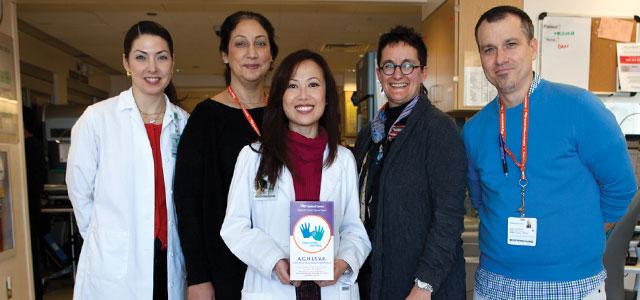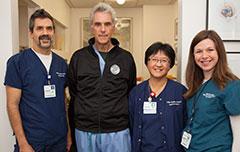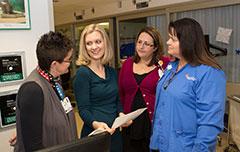
The ACHIEVE team, from left: Tina Mammone, Amy Nichols, Elizabeth Sin, Daphne Stannard, Alberto Garcia
The Value of “Why” Drives the Growth of On-Site Nurse Scientists
Hand hygiene is a source of concern in hospitals across the country. The reason is simple. When clinicians fail to wash their hands before a patient interaction – which happens as often as 70 percent of the time nationwide – they become a risk factor for hospital-acquired infections, which, according to a May 2013 article in the New York Times, can lead to almost 100,000 patient deaths a year. The cost nationwide is in the tens of billions of dollars.
With this in mind, UCSF Medical Center implemented a pilot study in its Neuro ICU designed to achieve the highest possible levels of hand hygiene compliance. Known as Project ACHIEVE – and led by Daphne Stannard, director and chief nurse researcher at UCSF Medical Center’s Institute for Nursing Excellence, and nurses Tina Mammone, Elizabeth Sin and Alberto Garcia, with Chief Medical Officer Josh Adler as executive sponsor – the study mounted cameras strategically throughout one of the medical center’s Neuro ICUs, using another Neuro ICU as the control unit. In addition to recording compliance with hand-washing protocols, in its second month the project gave clinicians near-real-time feedback via mounted electronic ticker-tape screens.
At the end of the two-month pilot, the nurses in the room with the video surveillance and ticker-tape feedback clearly demonstrated better hand hygiene compliance rates than their colleagues in a control group.
Over the last decade or two, the growing importance of the Magnet Recognition Program and health care reform’s emphasis on evidence-based practice have led to increasing numbers of medical centers and community hospitals hiring doctorally prepared nurse scientists like UCSF’s Stannard to conduct and oversee research like the hand hygiene project. The hiring of these nurse scientists appears to be improving both outcomes and patient satisfaction.
Seeking Nurse Scientists
“Nurses bring an important perspective that has long been overlooked or undervalued,” says Rosemary White-Traut, director of nursing research at Children’s Hospital of Wisconsin Research Institute.
“Few other scientists are interested in nursing practice, but nursing practice is the majority of what occurs in a hospital,” says White-Traut’s colleague Kathleen Sawin, professor and joint research chair in the nursing of children, Children’s Hospital of Wisconsin and University of Wisconsin-Milwaukee College of Nursing. “As nursing science has matured, the whole issue of nursing research in clinical settings has risen to the fore as an important contribution to health care and health policy.”
“When I was at Johns Hopkins [in the mid-1980s] and working for the first time with nurse scientists from the School of Nursing there, one of the things I began to really understand is the value of the word ‘why,’” says Sheila Antrum, chief nursing and patient care services officer at UCSF Medical Center. “Why do we do what we do? Why do we change? What evidence do we have that it makes a difference? The beauty of the nurse scientist is that he or she is close to patients and able to constantly push for ways to treat those patients better.”
“The [on-site] nurse scientist leads in the final translational step, the place where we find out what happens when you road test a discovery in the real world,” says Linda Franck, chair of the department of Family Health Care Nursing at UC San Francisco School of Nursing and a frequent collaborator on research projects at UCSF Medical Center. “Can you scale up across a whole patient population and get the same benefits seen in the controlled trial? Are there side effects or unintended consequences when outcomes of new treatments are tracked for longer periods? Nurses tend to gravitate toward such questions, and it’s great that we’re in a phase where hospitals are valuing this role.”
An added benefit, say many, is that the presence of a nurse scientist appears to have a snowballing effect. Entire nursing staffs become proficient at both asking questions and answering them in rigorous, evidence-based ways. Appreciating the value of “why” becomes infectious, and the positive effects for patients show up in ways both big and small, including reduced infections, reduced falls, decreased lengths of stay, healthier babies, more-informed parents, reduced readmissions and improved transitions from hospital to home.
Making the Commitment
With its creation of an Institute for Nursing Excellence and the hiring of a second nurse scientist – Amy Nichols – UCSF Medical Center has made an unmistakable commitment to hospital-based nursing research. Stannard gives at least part of the credit for that commitment to Antrum’s enthusiastic support.
“I love it,” says Antrum. “Nurses need to know why they’re doing what they’re doing. They are responsible. And nurses who don’t think along those lines or who become rote, become a problem.”
“The vision and role of the CNO is critical,” says Sawin. “That person can’t give lip service. She really has to be engaged in a journey to enhance the capacity for evidence-based care and new knowledge.”
Of course, not all CNOs or hospital administrations have the same priorities or budgets, so there is nothing uniform about the hospital-based nurse scientist’s role. However, generally they (1) bring existing research findings to the bedside, (2) guide and encourage small tests of change and quality improvement projects and (3) either independently or in collaboration with School of Nursing faculty, oversee publishable, “big R” research projects.
All of the duties, says Stannard, are rooted in the model of how knowledge is created and transferred – from discovery (primary or secondary research) to application (testing whether a new discovery or process is safe for patients) to applying the new knowledge across the board for patients and families. “At UCSF, all flavors of clinical inquiry are valued and equal,” says Stannard.
She and Nichols spend part of their time, therefore, helping interested nurses understand where their clinical question fits along the research continuum and finding a way to pursue answers. Is there already evidence out there, and is it a matter of understanding how to adapt it to a particular setting? Is there a need for a systematic review of existing literature? Or does a question demand some sort of primary research?
Overseeing Research Training and Education
Stannard also oversees research training and education for interested nurses via two programs. The first is the Joanna Briggs Institute (JBI), an international collaborative that houses a database of evidence-based tools. UCSF Medical Center houses the UCSF JBI Centre, which is a collaborating center in the Joanna Briggs global community. The center offers ongoing classes that teach nurses how to do systematic reviews and secondary research.
The second is an Evidence-Based Practice Fellows program, where nurses apply for and receive paid time off over five months to pursue their particular research interest. As an evidence-based practice fellow, neurosurgical nurse William Gersten (see sidebar) is expanding existing research on the administration of mannitol in brain tumor patients.
Yuliya Shakhlevich has also been an evidence-based practice fellow, using her time there on a project to reduce noise levels in the pediatric intensive care unit (see sidebar). “During the evidence-based program, every month you meet, and [Stannard] shows you different ways to collect data and do research,” she says. “It was good guidance.”
Stanford’s Lucile Packard Children’s Hospital has a similar program, says nurse scientist Annette Nasr, who in addition to her work at Packard is an adjunct faculty member at UC San Francisco School of Nursing, where she received her PhD. “We’re lucky that Packard has a very generous foundation that supports nursing and nursing research. In our advanced practice scholar program, nurses can do small research studies, and I assist in designing the study, the research question and methodology – and, when appropriate, moving the work into publications.”
Collaboration with Schools of Nursing
Stannard also collaborates with the School of Nursing on a variety of projects in a variety of ways. Franck says such collaborations add another element to the role of the nurse scientist. “Nurse scientists are the gatekeepers for research that involves patients and nurses, and they often participate in or facilitate partnerships that enhance the work,” says Franck.
Sometimes, she says, Stannard will connect a faculty member interested in doing hospital-based research with the appropriate people at the hospital. Other times, Stannard might refer one of her evidence-based practice fellows to a faculty member at the School who has an area of expertise that can help the nurse get to the appropriate literature or hone his or her study questions and research methods.
 From left: Maureen Buick, Linda Franck, Suzanne Ezrre, Carrie Meer, Jessica Hale As an example, Franck, who has expertise in validating assessment tools, is working with a nursing team led by Maureen Buick, director of nursing education and performance improvement at UCSF Medical Center, on a project to reduce pediatric falls, which is more of a clinical concern than one might expect.
From left: Maureen Buick, Linda Franck, Suzanne Ezrre, Carrie Meer, Jessica Hale As an example, Franck, who has expertise in validating assessment tools, is working with a nursing team led by Maureen Buick, director of nursing education and performance improvement at UCSF Medical Center, on a project to reduce pediatric falls, which is more of a clinical concern than one might expect.
“It’s actually a complex issue,” says Franck. “All falls are not the same.”
Sometimes a toddler who’s learning to walk bumps into things – which is not a problem in a normal, protected home environment, but in a hospital, the toddler might get tangled in tubes and wires and land on hard linoleum. Also, in a hospital setting, medications and illness can disorient kids and make them light-headed and more prone to falling.
“Maureen and her team realized there were no real good tools for assessing falls risk in kids and developed a child-focused assessment and prevention program,” says Franck. “They wanted to see if their program was making a real difference and if it could be improved, so with the help of one of our amazing master’s students, I partnered with them to evaluate their assessment tool and analyze the factors influencing the falls. We are still crunching the numbers, but already have had some really important ‘ahas’ that are directly influencing how they implement fall prevention going forward.”
Sawin believes the link between clinical setting and academic institution is essential, though she stresses that it has to be a respectful, two-way street. “I’m a doctorally prepared PNP and a long-time clinician, but in every study I do, there's a connection to a clinical group of colleagues engaged in making sure our work is relevant to their practice experience. I would never do a study without clinical partners,” she says.
Franck agrees and believes there remains untapped potential in these collaborations. By leveraging the faculty and student talent at schools like UCSF School of Nursing, she envisions a robust regional network to maximize the potential of hospital-based nurse scientists to contribute to improvements in patient care.
The Effect on Nursing Staff
There’s another advantage to the on-site nurse scientist. “[She] is the conduit for frontline nurses to be involved in more research opportunities than in the past,” says Jody Mechanic, director of professional nursing practice and Magnet program director at UCSF Medical Center.
“I’ve been a nurse for over 30 years, and there’s been a big change,” says neurosurgical nurse Vivien Ma-Wong. “Now we are more inquisitive, and if we find a better way that makes our job easier and is good for the patient, then I’m all for it.”
“You feel like you’re being treated as a professional and being encouraged to do things that are intellectually stimulating,” says Gersten. “I entered nursing at a master’s level [after working as a chiropractor for 21 years], so I’m very familiar with nursing research. The Evidence-Based Practice Fellows program gave me an outlet to do the research.”
“Nurses are more at the forefront of examining the quality of patient care than when I went to nursing school,” says Julie Reed, a doctorally prepared nurse on the palliative care service at Packard, who conducted a study to bring down noise levels in the PICU there. “It definitely makes my job more satisfying.”
Spreading the Knowledge
“Another thing nurse scientists do is engage other hospitals,” says Antrum, who says UCSF often works with Stanford, Packard and John Muir Health. “One of the things that’s wonderful about Magnet is they hold these conferences, where all these direct care nurses are asking all these amazing questions about improving care at the bedside.”
Children’s Hospital of Wisconsin, which is part of a consortium of hospitals, decided to try to expand its community and the growing knowledge base for nurse scientists when, in 2013, it ran a one-day conference for nurse scientists in pediatric settings.
“From a survey we did a few years ago, we published a paper where we tried to determine the structure of how nurse scientists were used, the barriers and some of the issues,” says Sawin. “The fly-in seemed like an opportunity to understand the current state of the role, especially since so many more children’s hospitals had instituted it over the last five years.”
“I also thought it would be great to develop some collaborations among children’s hospitals, especially since we often work with specific diagnoses, and patient populations are not always large enough at one institution to conduct valid studies,” says White-Traut. “We also wanted to find a way to share nursing research findings from children’s hospitals around the US.”
White-Traut and Sawin did not expect a huge response, but they wound up with 40 people attending from all over the US, including Nasr. “The evaluations of the meeting were so positive that we’re getting ready to plan a second one,” says White-Traut.
Challenges
Despite the burgeoning growth in on-site nurse scientists, most of the people in the role feel some challenges remain before the position achieves its full potential.
For one, there can be a mismatch between a nurse scientist’s broad training and perspective and the hospital’s goals – which are in many cases driven by short-term concerns relating to accreditation and patient satisfaction. Sometimes, many say, a nurse scientist is hired with the best of intentions, but the needs and resources shrink as the economic environment changes.
Another challenge is that not everyone always has a clear idea of what nursing-led research is or is supposed to accomplish.
“I had a meeting with the dean of the School of Medicine where he asked me directly what nursing research is,” says Nasr. “My answer was that it’s hard to segregate research questions based on clinical area. Like medical research, nursing research is a systematic, scientific investigation of phenomena leading to generalizable knowledge, but nurses tend to be more focused on outcomes, cost and quality as opposed to bench science. There is some overlap – and there’s been a steady increase in interdisciplinary research.”
“I’ve heard people say the research carried out by nurses is not real research, and I think that’s offensive,” says Reed. “A lot of what we’re looking at has the potential to keep people out of the hospital and impact care at the bedside, which I feel is so much of what patients and families want. The bedside is where you start to see what is working and not working. Other research is important, but it’s not more important; they have to work together.”
“Because nurses are with patients 24/7, a lot of nursing research looks at the impact of our practice on patient outcomes at the point of care,” says Nichols. “How can we help the patient and family avoid that 30-day readmit? Or what are the factors that can delay a transfer? Maybe more macro-level questions that can affect things like staffing ratios and hospital policy.”
“My physician colleagues’ work is useful and important to me, but we bring a focus on things like the patient experience, the human response to illnesses and conditions, patient self-management and end-of-life care – things related to managing the challenges of diseases we don’t yet know how to cure,” says Sawin.
Creating Opportunities for Nurses and Patients
Despite the remaining challenges, the growth of interest in many settings is creating exciting new opportunities for nurses.
“There are now more places for our graduates to practice while staying involved in science,” says Franck.
“Maybe after entering the academic world, nurses who received PhDs from UCSF and other institutions miss the clinical setting and want to be closer to patients,” says Nasr. “This is a role where we can make a difference for both science and patients.”
“Part of practicing to the top of our scope is applying evidence-based research and making clinical decisions based on that knowledge,” says Stannard. “But you need somebody to help guide that.… That’s the nurse scientist’s role.”





